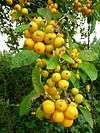Malus
Malus (/ˈmeɪləs/[2] or /ˈmæləs/) is a genus of about 30–55 species[3] of small deciduous trees or shrubs in the family Rosaceae, including the domesticated orchard apple (M. domestica syn. M. pumila) – also known as the eating apple, cooking apple, or culinary apple. The other species are commonly known as crabapples, crab apples, crabtrees, or wild apples.
| Malus | |
|---|---|
| Malus ‘Purple Prince’[1] | |
| Scientific classification | |
| Kingdom: | Plantae |
| Clade: | Tracheophytes |
| Clade: | Angiosperms |
| Clade: | Eudicots |
| Clade: | Rosids |
| Order: | Rosales |
| Family: | Rosaceae |
| Subfamily: | Amygdaloideae |
| Tribe: | Maleae |
| Subtribe: | Malinae |
| Genus: | Malus Mill. |
| Type species | |
| Malus sylvestris Mill. (1768) | |
| Species | |
|
See text | |
The genus is native to the temperate zone of the Northern Hemisphere.
Description
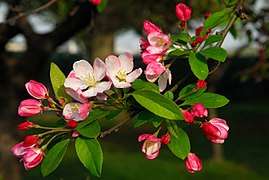
Apple trees are typically 4–12 m (13–39 ft) talI at maturity, with a dense, twiggy crown. The leaves are 3–10 cm (1.2–3.9 in) long, alternate, simple, with a serrated margin. The flowers are borne in corymbs, and have five petals, which may be white, pink or red, and are perfect, with usually red stamens that produce copious pollen, and a half-inferior ovary; flowering occurs in the spring after 50–80 growing degree days (varying greatly according to subspecies and cultivar).
Many apples require cross-pollination between individuals by insects (typically bees, which freely visit the flowers for both nectar and pollen); these are called self-sterile, and therefore self-pollination is impossible, making pollinating insects essential.
There are a number of cultivars which are self-pollinating, such as Granny Smith and Golden Delicious. There are considerably fewer of these, compared to their cross-pollination dependent counterparts.
Several Malus species, including domestic apples, hybridize freely.[4] They are used as food plants by the larvae of a large number of Lepidoptera species; see list of Lepidoptera that feed on Malus.
The fruit is a globose pome, varying in size from 1–4 cm (0.39–1.57 in) diameter in most of the wild species, to 6 cm (2.4 in) in M. sylvestris sieversii, 8 cm (3.1 in) in M. domestica, and even larger in certain cultivated orchard apples. The centre of the fruit contains five carpels arranged star-like, each containing one or two seeds.
Subdivisions and species
There are about 42 to 55 species and natural hybrids with about 25 from China, of which 15 are endemic. The genus Malus is subdivided into eight sections (six with two added in 2006 and 2008).
| Subgenus | Image | Scientific name | Common name | Distribution |
|---|---|---|---|---|
| Section Chloromeles (Decaisne) Rehd. | Malus angustifolia (Aiton) Michx. | southern crabapple | Eastern and south-central United States from Florida west to eastern Texas and north to New Jersey, Pennsylvania, Illinois and Missouri | |
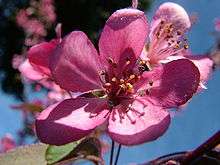 |
Malus coronaria (L.) Mill. | sweet crabapple | Great Lakes Region and in the Ohio Valley, United States | |
 |
Malus ioensis (Alph.Wood) Britton | prairie crabapple | upper Mississippi Valley,United States | |
| Malus brevipes (Rehder) Rehder | shrub apple | |||
| Section Docyniopsis Schneid. | Malus doumeri (Bois) A.Chev. | Taiwan crabapple | China(Guangdong, Guangxi, Guizhou, Hunan, Jiangxi, Yunnan, Zhejiang), Taiwan, Laos, Vietnam | |
| Malus leiocalyca S. Z. Huang | China (Anhui, Fujian, Guangdong, Guangxi, Hunan, Jiangxi, Yunnan, Zhejiang) | |||
| Malus tschonoskii (Maxim.) C.K.Schneid. | Chonosuki crabapple and pillar apple | Japan. | ||
| Section Eriolobus (Seringe) Schneid | 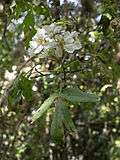 |
Malus trilobata (Poir.) C.K.Schneid. | Lebanese wild apple, erect crabapple, or three-lobed apple tree | Asia includes West and South Anatolia, Syria, Lebanon and North Israel, Europe from east section of Greek Thrace (Evros Prefecture) and southeastern Bulgaria |
| Section Florentinae (Rehder) M.H.Cheng ex G.Z.Qian[5] | 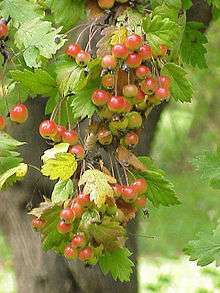 |
Malus florentina (Zucc.) C.K.Schneid. | Florentine crabapple, hawthorn-leaf crabapple | Balkan Peninsula and Italy |
| Section Gymnomeles Koehne |  |
Malus baccata (L.) Borkh. 1803 | Siberian crabapple | Russia, Mongolia, China, Korea, Bhutan, India and Nepal |
 |
Malus halliana Koehne 1890 | Hall crabapple | Japan and China | |
| Malus hupehensis (Pamp.) Rehder 1933 | tea crabapple | China | ||
| Malus mandshurica (Maxim.) Kom. ex Skvortsov | Manchurian crabapple | China, Japan, eastern Russia | ||
_(1444)_Relic38.jpg) |
Malus sikkimensis Wenz.) Koehne ex C.K.Schneid. | Sikkim crabapple | China, Nepal, Bhutan, and India | |
| Malus spontanea (Makino) Makino | Japan | |||
| Section Malus Langenfelds |  |
Malus asiatica Nakai | Chinese pearleaf crabapple | China and Korea. |
| Malus chitralensis Vassilcz. | Chitral Crab Apple | India, Pakistan | ||
| Malus crescimannoi Raimondo | north-eastern Sicily | |||
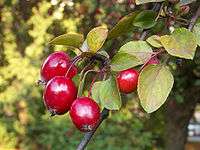 |
Malus floribunda Siebold ex Van Houtte | Japanese flowering crabapple | Japan and East Asia | |
| Malus muliensis T.C.Ku | China (Sichuan) | |||
| Malus orientalis Uglitzk. | Armenia, Georgia, Turkey, and Russia | |||
 |
Malus prunifolia (Willd.) Borkh. | plum-leaf crabapple, Chinese crabapple | China | |
.jpg) |
Malus domestica Miller, 1768 | orchard apple, includes Malus niedzwetzkyana and M. pumila | Central Asia (Mountains of Kazakhstan)[6] | |
 |
Malus sieversii (Ledeb.) M.Roem. | Central Asia in southern Kazakhstan | ||
 |
Malus spectabilis (Aiton) Borkh. | Asiatic apple, Chinese crabapple | China (Hebei, Jiangsu, Liaoning, Qinghai, Shaanxi, Shandong, Sichuan, Yunnan, and Zhejiang) | |
| Malus sylvestris (L.) Mill. | European crabapple | Europe | ||
| Malus zhaojiaoensis N.G.Jiang | Zhaojiao crab apple | China (Sichuan) | ||
| Section Sorbomalus Zabel | 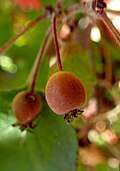 |
Malus fusca (Raf.) C.K.Schneid. | Oregon or Pacific crabapple | western North America from Alaska, through British Columbia, to northwestern California. |
| Malus kansuensis (Batalin) C. K. Schneider | Calva crabapple | China (Gansu, Henan, Hubei, Shaanxi, Sichuan) | ||
| Malus komarovii (Sarg.) Rehder | China, Manchuria, and North Korea. | |||
 |
Malus sargentii Rehder. | Sargent crabapple | Japan | |
 |
Malus toringo (Siebold) de Vriese | Toringo crabapple or Siebold's crabapple | eastern temperate Asia, in China, Japan, and Korea | |
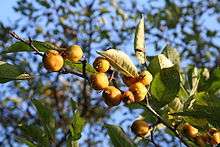 |
Malus toringoides Hughes | cut-leaf crabapple | China(Shaanxi, Gansu, Ningxia, Qinghai and Sichuan) | |
 |
Malus transitoria C.K.Schneid. | cut-leaf crabapple | China (Gansu, Nei Mongol, Qinghai, Shaanxi, Sichuan, E Xizang) | |
 |
Malus zumi (Matsum.) Rehder | Japan (Honshu) | ||
| Section Yunnanenses (Rehd.) G.Z.Qian[7] | Malus honanensis Rehder. | Honan Crabapple | China (Gansu, Hebei, Henan, Hubei, Shaanxi, Shanxi.) | |
| Malus ombrophila Handel-Mazzetti | China (Sichuan, Xizang,Yunnan) | |||
| Malus prattii (Hemsl.) C.K.Schneid. | Pratt's crabapple | China (Guangdong, Guizhou, west Sichuan, and northwest Yunnan) | ||
| Malus yunnanensis C.K.Schneid. | Yunnan crabapple | China (Yunnan) | ||
Natural Hybrids
- Malus × micromalus – midget crabapple
Cultivation
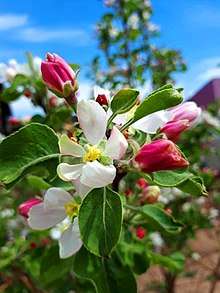
For the Malus pumila cultivars, the culinary, and eating apples, see Apple.
Crabapples are popular as compact ornamental trees, providing blossom in Spring and colourful fruit in Autumn. The fruits often persist throughout Winter. Numerous hybrid cultivars have been selected. The following have won the Royal Horticultural Society’s Award of Garden Merit:-[8]
Other varieties are dealt with under their species names.
Some crabapples are used as rootstocks for domestic apples to add beneficial characteristics.[16] For example, varieties of baccata, also called Siberian crab, rootstock is used to give additional cold hardiness to the combined plant for orchards in cold northern areas.[17]
They are also used as pollinizers in apple orchards. Varieties of crabapple are selected to bloom contemporaneously with the apple variety in an orchard planting, and the crabs are planted every sixth or seventh tree, or limbs of a crab tree are grafted onto some of the apple trees. In emergencies, a bucket or drum bouquet of crabapple flowering branches are placed near the beehives as orchard pollenizers. See also Fruit tree pollination.
Because of the plentiful blossoms and small fruit, crabapples are popular for use in bonsai culture.[18][19][20]
Uses


Crabapple fruit is not an important crop in most areas, being extremely sour due to malic acid (which like the genus derives from the Latin name mālum), and in some species woody, and for this reason is rarely eaten raw. In some southeast Asian cultures they are valued as a sour condiment, sometimes eaten with salt and chili pepper, or shrimp paste.
Some crabapple varieties are an exception to the reputation of being sour, and can be very sweet, such as the 'Chestnut' cultivar.[21]
Crabapples are an excellent source of pectin, and their juice can be made into a ruby-coloured preserve with a full, spicy flavour.[22] A small percentage of crabapples in cider makes a more interesting flavour.[23] As Old English Wergulu, the crab apple is one of the nine plants invoked in the pagan Anglo-Saxon Nine Herbs Charm, recorded in the 10th century.
Apple wood gives off a pleasant scent when burned, and smoke from an apple wood fire gives an excellent flavour to smoked foods.[24] It is easier to cut when green; dry apple wood is exceedingly difficult to carve by hand.[24] It is a good wood for cooking fires because it burns hot and slow, without producing much flame.[24]
Crab apple has been listed as one of the 38 plants whose flowers are used to prepare the Bach flower remedies.[25]
Cultivars
References
- Cirrus Digital Purple Prince Crabapple
- Sunset Western Garden Book, 1995:606–607
- Phipps, J.B.; et al. (1990). "A checklist of the subfamily Maloideae (Rosaceae)". Can. J. Bot. 68 (10): 2209–2269. doi:10.1139/b90-288.
- Ken Wilson and D.C. Elfving. "Crabapple Pollenizers for Apples". Ontario Ministry of Agriculture and Food. Retrieved 12 Sep 2013.
- GUAN-ZE QIAN, LIAN-FEN LIU, DE-YUAN HONG, GENG-GUO TANG (2008). "Taxonomic study of Malus section Florentinae (Rosaceae)". Botanical Journal of the Linnean Society. 158 (2): 223–227. doi:10.1111/j.1095-8339.2008.00841.x.CS1 maint: uses authors parameter (link)
- "The History of the "Forbidden" Fruit". www.nationalgeographic.com. National Geographic Partners. Retrieved July 22, 2014.
- G.-Z. Qian, L.-F. Liu, G.-G. Tang (2006). "A new section in Malus (Rosaceae) from China" (PDF). Annales Botanici Fennici. 43 (1): 68–73. JSTOR 23727279.CS1 maint: uses authors parameter (link)
- "AGM Plants - Ornamental" (PDF). Royal Horticultural Society. July 2017. p. 63. Retrieved 2 April 2018.
- "RHS Plantfinder - Malus 'Adirondack'". Retrieved 25 March 2018.
- "RHS Plantfinder - Malus 'Butterball'". Retrieved 25 March 2018.
- "RHS Plantfinder -Malus 'Evereste'". Retrieved 25 March 2018.
- "RHS Plantfinder - Malus Jelly King = 'Mattfru'". Retrieved 25 March 2018.
- "RHS Plantfinder - Malus 'Laura'". Retrieved 25 March 2018.
- "RHS Plantfinder - Malus × robusta 'Red Sentinel'". Retrieved 25 March 2018.
- "RHS Plantfinder - Malus 'Sun Rival'". Retrieved 25 March 2018.
- Apple Tree Rootstocks Ecogardening Factsheet #21, Summer 1999
- Alaska Department of Natural Resources Archived 2008-07-19 at the Wayback Machine
- Biel, John. "Collecting and Training Crab Apples | American Bonsai Society". www.absbonsai.org. American Bonsai Society. Archived from the original on 3 July 2016. Retrieved 2 August 2016.
- "Crabapple (Malus) - Bonsai Empire". www.bonsaiempire.com. Retrieved 2 August 2016.
- Walston, Brent. "Crabapples for Bonsai". evergreengardenworks.com. Retrieved 2 August 2016.
- "The Growing Guide". Stark Bro's Nurseries & Orchards Co.
- Rombauer, I.; Becker, M. R.; Becker, E. (2002) [2002]. All About Canning & Preserving (The Joy of Cooking series). New York: Scribner. p. 72. ISBN 0-7432-1502-8.
- "The Science of Cidermaking". Andrew Lea. Retrieved November 14, 2013.
- Fraser, Anna (22 August 2005). "Properties of different trees as firewood". Retrieved 17 July 2008.
- D. S. Vohra (1 June 2004). Bach Flower Remedies: A Comprehensive Study. B. Jain Publishers. p. 3. ISBN 978-81-7021-271-3. Retrieved 2 September 2013.
- "Malus x adstringens 'Durleo' 'Gladiator Crabapple'". Countryside Garden Centre. Countryside Garden Centre. Retrieved 6 June 2016.
External links
| Wikimedia Commons has media related to Malus. |
- Germplasm Resources Information Network: Malus
- Flora of China: Malus
- Virginia Cooperative Extension - Disease resistant crabapples Archived 8 February 2007 at the Wayback Machine
- The PRI disease resistant apple breeding program: a cooperative among Purdue University, Rutgers University, and the University of Illinois.
